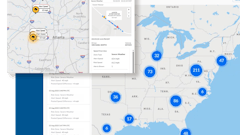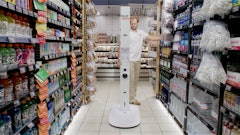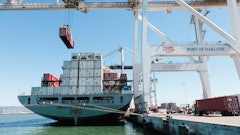"For the consumer packaged goods (CPG) industry, like most industries today, time is money," says Patrick Arlequeeuw, a vice president at the Procter & Gamble Co., the Cincinnati--based consumer products giant. "The longer the supply network, the more costly it is. Clearly, there's a compelling business case for increasing the speed and flexibility of the supply network to deliver new product innovations that are in rhythm with retailer and consumer expectations."
Roddy Martin, vice president of industry strategies for consumer packaged goods at AMR Research, Boston, calls such a process the Demand--Driven Supply Network (DDSN). He describes it as a system of technologies, processes and capabilities to sense and respond to real--time de'mand signals across a network of suppliers, customers and em'--ploy''ees.
Actually, this vision has been around since the late 1980s.
"Continuous replenishment was a very early example of companies trying to implement a demand--driven supply capability. It really did start reflecting what consumers were buying, and companies used that to drive the replenishment process," recalls Ralph Drayer, president of Supply Chain Insights, a Cincinnati--based consultancy.
Unfortunately, back then the technology and the operational savvy were neither available nor commercially viable to take the process to the next level. That is changing. Companies are taking steps-'albeit baby steps-'to move from an internally--focused supply chain to a network that reacts to consumer demand.
"DDSN is still in its infancy," says Kevin McNelly, vice president of solution management at Manugistics Group Inc., Rockville, MD. "Manufacturers are no longer pushing the product. Instead, they want to be leaner and align their operations to respond to demand pulls through their supply network. The days of manufacturers operating by stocking up on inventory and then responding to demand does not work anymore. The second a product is taken from the shelf, the wheels should already be in motion to meet that demand. Manufacturers need to continue their focus on the customer, aligning around customer demands, and ultimately minimizing their inventory."
Martin of AMR Research stresses that DDSN is not another IT project, but an operational strategy. He says only one company is taking the process to the next level: Procter & Gamble.
"P&G is pursuing a strategy we call 'Consumer-Driven Supply Network,' which drives retail customer and consumer needs deeper into the supply network with a goal of increasing responsiveness and flexibility," says Arlequeeuw, who directs this initiative for the company. "Ultimately, it will allow us to better address the needs of our retail partners and the consumers we both serve."
Satisfying The Retailer, Consumer
According to Arlequeeuw, the idea behind a supply network is that all of the stakeholders in the supply chain work together in real time to meet retailers' and consumers' needs.
The common vision in the CPG industry is that a consumer purchase triggers real--time information movement to the supply network. This will offer significant benefits to retailers who can help make this vision a reality, he says, by supporting the development of industry standard processes and providing access to data that offers a common view of demand.
"This really requires a fundamental change in thought on how supply networks are designed," he explains, "looking at the supply system from the shelf back and determining what is required to deliver the desired consumer experience. This will require a close partnership with our retail customers and suppliers. This collaboration is key because it should give us the visibility we need along the entire network, from the store shelf back, to efficiently design and deliver what is required."
Are any other large CPG companies besides P&G looking seriously into supply chain networks?
"I'm sure the leaders are and are at various stages because the pay--off here is huge," says Drayer, the consultant. "This is a transformational business strategy. It really is starting with a focus on the customer and commitment to the customer across a corporation. I mean functional alignment to the common focus on the customer to reinvent business processes in order to sense and react to real time demand quicker."
Martin of AMR Research lists several companies that are "knocking on the door" of this network strategy: Kraft, Pfizer, General Mills, Unilever and others. He has presented to executive teams of major pharmaceutical and CPG companies who have responded favorably. In fact, he is now helping many companies build their DDSN strategy.
Getting started, however, takes a thorough commitment.
"First, companies will have to embrace ways to make their processes more flexible, not only in manufacturing, but also in their transportation operations so that they can rapidly adjust and effectively respond to their customer demands in an efficient manner," says McNelly of Manugistics. "Second, DDSN will require companies to get different data and have a more agile supply chain infrastructure that is capable of responding in near--time so that they can actually take real--time demand signals, such as POS data, and facilitate the rebalance of inventory and the rebalance of demand-'furthering the flexibility of a company's operations and its focus on what the customer wants."
Karin Bursa, vice president of marketing at Logility Inc., Atlanta, points out that DDSN means breaking down cultural and departmental barriers for "fluid decision-making," to enable companies to adapt and respond to changes in demand quickly and efficiently. Such a commitment starts with complete buy--in and commitment to drive change.
"DDSN must embrace all areas of an organization and get everyone marching to the same beat-'that of the customer," she says. "The largest obstacle is the cultural change required of employees to think beyond their departments, and this will require executive management to rethink incentives that support corporate supply chain metrics, not department ones. For example, what if sales were measured (in part) on forecast accuracy? A second obstacle has been technology. The DDSN vision has existed in some form for many years, but only with the advance of technology have we reached the point now that the vision can start to become a reality."
McNelly of Manugistics points out another obstacle to moving into supply chain networks: the quality and availability of POS data which is crucial to receiving fast demand signals.
"The POS data that companies are receiving is not always accurate or usable to begin with," he says. "Yet many continue to apply this information because it is the only thing they have, as retailers protect their own POS data and avoid sharing it."
"Open--sharing of POS information across the supply chain between consumer goods companies and retailers is vital to efficiently manage the supply chain to meet customer demands and to diminish the business and cultural friction between the two and ultimately create a supply chain ecosystem."
Faster, More Responsive Networks
When such a vision of DDSN becomes a reality, many benefits will be attained. They range from cost savings and speed to market to lower inventories and fewer stock--outs. Retailers and consumers will benefit as well.
"Recognizing that the success of all supply network partners is interdependent, P&G looks at this from the standpoint of how it will benefit consumers and retailers," says Arlequeeuw. "For consumers, a demand--driven supply network should put the right product on the shelf at the right time and value. In other words, it should allow us to successfully manage the increasing flow of innovative new products to the store. This benefits retailers as well, because new product innovations and new categories build their business."
"DDSN benefits start with less time and cost tied up in the supply network," he continues, "and taking these out will enable a faster, more responsive and more flexible supply network. This can be measured as lower inventories and fewer out of stocks. At P&G, the percent of categories in which our products have higher than 5 percent out of stocks have decreased from 57 percent to 40 percent. Compared to five years ago, we have two to three times more SKUs, yet total costs are lower, inventories are in better control and volume is growing."
Bursa of Logility provides other benefits in the area of demand planning. Recent industry research, she reports, shows that a 5 percent improvement in demand forecast accuracy correlates to a 10 percent improvement in perfect orders (orders delivered complete, accurate, on time and in perfect condition) and a 10 percent improvement in perfect orders can yield 50 cents better earnings per share.
Drayer says, "If you're synchronized and working in harmony with your supply chain partners-'that means your suppliers on one end and your customers on the other-'and you're really beginning to operate as if it were one company'-that is, eliminating all the buffer inventory, eliminating all the friction that typically transpires between partners in a supply chain-'you can become more responsive by being quicker to market with new products. You can eliminate a lot of inefficiencies at all the interfaces, and you can start drawing on the intellectual capital of these different partners in the supply network. That's where the real power and savings are going to come from."
He is quick to point out the benefits of a supply network for retailers, as well as for manufacturers. He lists a higher in--stock, being first to market with new products, faster inventory turns and fewer handlings.
A supply network raises trading partner cooperation to another level, according to Drayer. He views it as the latest step over the years in a series of collaborative initiatives that include ECR, category management and joint business planning.
-----------------------------------------------------------
Selecting Software For DDSN
What is the best software for Demand--Driven Supply Networks?
Tips for selecting DDSN--enabled software range from looking for solutions that use a collaborative framework for easy communications to those that provide predictive analysis, according to executives from two leading providers.
"Companies should select solutions from providers with deep domain expertise," says Kevin McNelly, vice president of solution management at Manugistics Group Inc., Atlanta.
He says providers should be focused on:
*Delivering a successful solution that solves problems and issues and ultimately meets customer demands;
*Managing and linking global supply chain ecosystems;
*Measuring success across these complex supply chains;
*Providing predictive analysis and intelligent exception messaging based on the business metrics.
"A good forecast is the first step in a demand--driven supply network," says Karin Bursa, vice president of marketing at Logility Inc., Atlanta. "Select a solutions provider that specializes in delivering demand planning solutions specifically for consumer goods companies. Look for strong collaboration and the flexibility to supply scenario--based planning and 'what-if' analysis. Ask for several references."
Bursa also recommends the following:
*Look for solutions that use a collaborative framework for easy communications across internal departments, suppliers and cus'tom'ers. Integrate this into the sales and operations planning process.
*Demand-driven networks require real--time feedback. So evaluate solutions that include built--in performance management capabilities that will enable users to react to events and prevent late orders.
*With the right software, manufacturers and retailers will benefit, according to the software executives.
"Many CPG companies have done a great job of bringing down supply chain costs, but they still need to improve customer--level planning and the percentage of perfect orders; that is, orders delivered complete, accurate, on time and in perfect condition," says Bursa. "With the collaborative nature of a DDSN approach, CPG companies can anticipate reaping more improvements in customer service levels, operations and financial performance when planning for specific needs by key customer or channel."
McNelly of Manugistics reports the disturbing results of a post--holiday survey his company conducted on consumer behavior prior to, during and after their holiday shopping experience. Nearly half (49 percent) of holiday shoppers said they easily found everything they were looking for the first time. About 35 percent said they occasionally were not able to find the gift they were looking for on store shelves, had to ask for employee help, or even left the store empty handed.
"These figures are simply not good enough if retailers and consumer goods companies want to remain competitive and meet their financial goals," he says. "Especially considering that 58 percent of Americans surveyed said if they didn't find the item they were shopping for at one store, they went elsewhere."
Maybe they won't have to if a demand--driven supply network is in place. -'J.K.
-----------------------------------------------------------
Demand Management:
A Core Competency In The Battle For Market Share
Demand management is a huge issue in the food industry. In speaking with more than 300 sales, marketing, operations and supply chain executives in the food industry over the past two years, I have identified four key issues that are driving the move to improve demand management:
Lack of demand visibility: Sixty percent of companies feel their demand forecasting process is flawed and lacks a sufficient level of detail to support a production plan. Less than 20 percent of companies believe they have a workable sales and operations planning process in place.
Resource allocation to meet variable demand patterns: More than 80 percent of companies fall back on poor demand forecasts as a root cause for inefficient capacity utilization and inventory deployment. More than 90 percent of companies find little or no support from sales people in helping to predict volatile demand patterns.
Managing the customer fulfillment process: While 75 percent of companies have a handle on customer profitability at some aggregated level, more than 50 percent of companies say detailed and quickly available customer profitability was lacking and seen as a true need.
A formalized supplier measurement program: Fewer than 30 percent of companies have a supplier management system in place that includes dashboard--based scorecards, trend analysis and root cause analysis. More than 80 percent of companies without formalized supplier measurement systems believe that scorecarding is a valuable asset that they have placed on their priority list for the future.
Yet even though some food companies deem demand management as important, they still don't consider it important enough to truly work on improvement programs. Companies still have difficulty in understanding how to improve forecast accuracy, especially when it comes to understanding what the improvement is worth in profit and asset utilization.
The approach to which many food manufacturers have turned is to implement an internal collaborative forecasting process driven from a more sophisticated bottoms--up statistical forecasting approach. In today's world of supply chain tools, users need only a rudimentary knowledge of data analysis and statistics, and should be expected to primarily deal with exceptions to the forecasting process driven by predetermined business rules such as absolute forecast error.
Why is this important? In many cases, demand forecasting is the single biggest item causing customer service problems, increased inventory, longer customer lead times, and ultimately higher product costs. Food companies that view demand management as a core competency are more competitive, more agile, and more profitable.-'John Hughes
Hughes is the senior vice president of sales and marketing at Silvon Software Inc., Westmont, IL.















